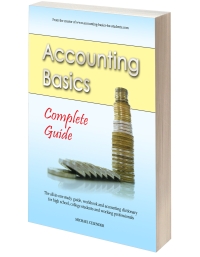Liabilities:
Definition and Examples
Previous lesson: What are Assets?
Next lesson: What is Owners Equity?
Welcome to our lesson on liabilities! In this lesson we're going to define exactly what liabilities are, then go over several common examples you'll find in accounting and the business world.
Check out the quiz on this lesson in the Test Yourself! section further below when you're done. And right at the bottom of the page, more questions on the topic submitted by fellow students.
Defining Liabilities
A liability is officially defined as:
A present obligation of the entity as a result of past events, the settlement of which is expected to result in an outflow of the entity's resources (payment).
In other words, a liability is simply:
A debt of the business.
YOU --------------------> OWE --------------------> BANK
The debt will result in assets, usually cash, leaving the business at some point in the future.
In accounting, liabilities are shown as a certain monetary amount. For example, a business is said to have $50,000 liabilities, meaning $50,000 debts to pay off.
Examples of Liabilities
Here are some of the most common liabilities you will find when studying and practicing accounting:
Loans
The most common liability is a loan.
Most loans are from financial institutions like banks. However, it's also possible to obtain loans from other organizations, or even individuals.
Loans are commonly used to finance major purchases, such as property, vehicles or machinery.
Loans are classified as long-term liabilities, as we expect to pay them off over an extended period, usually over a number of years.
Creditors
Another common liability is called creditors.
A creditor is any business or person that you owe (apart from a loan or any similar long-term debts).
Suppliers, who you owe for products and services purchased on credit, would fall under creditors.
Other examples of creditors are the telephone company that you owe or a printing shop you owe for printing fliers. Even the tax authorities could be considered a creditor if you owe them.
Creditors are also sometimes referred to as payables.
Creditors are short-term liabilities, as we usually expect to pay them over a period of a few months or less.
Credit Card Debt
It is also fairly common for a business owner to take out a credit card and use this to make purchases of products and services for the business.
Credit cards give an individual a certain amount of credit that can be used to make purchases, usually at a higher interest rate than a bank loan. It enables the business to pay for things when there is a temporary shortage of cash.
Credit cards usually require a minimum monthly payment.
When you pay back a loan, credit card or any of your creditors, some of your assets (most often cash) will leave your business.
Want to see some common liability transactions and their effect on the accounting equation - taking out a loan and paying it back?
Click here for our later lesson Accounting Equation: Liability Examples.
Test Yourself!
Before you start, I would recommend to time yourself to make sure that you not only get the questions right but are completing them at the right speed.
Difficulty Rating:
Beginner
Quiz length:
3 questions
Time limit:
5 minutes
Important: The solution sheet on the following page only shows the solutions and not whether you got each of the questions right or wrong. So before you start, get yourself a piece of paper and a pen to write down your answers. Once you're done with the quiz and writing down your answers, click the Check Your Answers button at the bottom and you'll be taken to our page of solutions.
Good luck!
Okay, that's it for our lesson on liabilities. I hope this basic accounting concept is clearer now.
In our next lesson we're going to define and clarify the final element of the basic accounting equation, owners equity.
Stay up to date with ABfS!
Follow us on Facebook:
Return from Liabilities: Definition and Examples to Basic Accounting Concepts
Return from Liabilities: Definition and Examples to the Home Page
*Greatful thanks to Svilen Mushkatov for permission to use his "Bank Building" image on this website (shown in the diagram above).
Previous lesson: What are Assets?
Next lesson: What is Owners Equity?
Questions Relating to This Lesson
Click below to see questions and exercises on this same topic from other visitors to this page... (if there is no published solution to the question/exercise, then try and solve it yourself)
What is an Outstanding Salary?
Q: What is the definition of outstanding salary??
A: Outstanding salaries are salaries that are due and have not yet been paid.
For example, …
Examples of Liabilities
Q: Give an example of a liability.
Who or what is a Supplier?
Q: I don't understand the meaning of supplier... who is a supplier?
A: A supplier is a business or individual that supplies your business (you) with …
Why is the Provision for Doubtful Debts a Liability?
Q: Why is the provision for doubtful debts a liability?
A: A provision is a loss or expense that will definitely occur in the future, but we don't …
© Copyright 2009-2023 Michael Celender. All Rights Reserved.
Click here for Privacy Policy.









Comments
Have your say about what you just read! Leave me a comment in the box below.